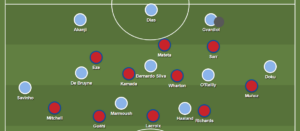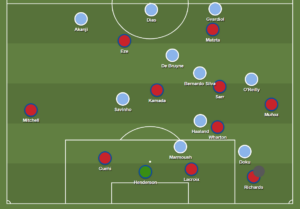Crystal Palace – Manchester City: Eze Sends Eagles To New Heights (1-0)
Oliver Glasner set up Crystal Palace to defend and counter in this FA Cup Final, and the plan ended up working. Eberechi Eze scored the decisive goal from a brilliantly constructed attack, while Palace’s defending was just about able to overcome Pep Guardiola’s interesting attacking scheme, securing the club’s first ever major trophy.
Tactical analysis and match report by Josh Manley.
We decided to make this article free to read. If you want to support our work, consider taking a subscription.
Manchester City’s season has been poor by their usual standards, but they still had the chance to salvage some silverware at the weekend with an FA Cup Final against Crystal Palace – a club looking to win their first ever major trophy.
Oliver Glasner’s side gave an excellent tactical performance in their semi-final win over Villa, and went with a similar setup here. They used a 3-4-3 system, with a back three of Chris Richards, Maxence Lacroix, and Marc Guéhi. Daniel Muñoz and Tyrick Mitchell were the wing-backs, while Adam Wharton and Daichi Kamada partnered in central midfield. Ismaïla Sarr and Eberechi Eze then supported Jean-Philippe Mateta up front.
Pep Guardiola opted to start with a 4-2-3-1 formation here, with Manuel Akanji, Rúben Dias, Joško Gvardiol, and Nico O’Reilly in the backline. Bernardo Silva and Kevin De Bruyne played in central midfield, while Savinho and Jérémy Doku were the wingers. Omar Marmoush then played in behind striker Erling Haaland.
Pep’s attacking plan
There were no prizes for guessing who would dominate the possession in this game and what the overall flow of the match would look like. From early on, City pinned Palace back into their own half and enjoyed nearly eighty percent of the possession over the course of the match.
Guardiola is known to be slightly unpredictable with his tactics in big games, often trying to find a special adaptation for the opponent his team will face. This time around, he opted for a nominal 4-2-3-1 shape, which then turned into a 3-3-4 formation when City had the ball.

City’s 3-3-4 attacking shape with De Bruyne and O’Reilly in the halfspaces.
The back three was formed by Akanji, Dias, and Gvardiol. O’Reilly would push forward in the left halfspace, while Bernardo Silva played centrally in the midfield line and De Bruyne started from the right halfspace. Savinho and Doku were wide, while Marmoush and Haaland played as a front two.
Palace meanwhile defended in a 5-4-1 shape, but with Mateta dropping far back as striker to assist his central midfielders. The intention from Guardiola with his system seemed to be to try and free De Bruyne and O’Reilly in the halfspaces, from where they could then try to create chances.
There were a couple of ways in which the structure lent itself to this purpose. Firstly, with a chain of three at the back, they could look to draw Sarr and Eze forward when City’s wide center-backs had the ball, potentially opening larger spaces for De Bruyne and O’Reilly.
Marmoush and Haaland played on the last line, attempting to occupy all three Palace center-backs and therefore prevent Palace’s wide center-backs from stepping into midfield to get close to De Bruyne and O’Reilly. Furthermore, Bernardo Silva’s positioning in central midfield put him between Palace’s central midfielders, attempting to distract them from their defense of the halfspaces.
Palace’s chain of five at the back meant that even if City could progress past the midfield line, there was still plenty of work to do though. Marmoush and Haaland struggled to get involved much, finding themselves crowded out in Palace’s compact defensive shape.

Plenty of ball circulation for City, but their strikers found it hard to get into the game against Palace’s defensive numbers.
The other key avenue for City was the wingers. They often looked for Savinho and Doku to beat the Palace wing-backs with their dribbling. This could of course also be supplemented with underlapping runs from City’s midfielders.
City made one or two decent chances, plus a penalty that was missed in the first half. However, overall Palace’s defensive scheme proved quite solid, as it had done in the semi-final. Glasner has organised his side well, and they played with excellent intensity on this big occasion.
Palace’s right-side threat
Despite City’s domination, it was Palace who scored early on, with what proved to eventually be the decisive goal in the game. The goal was a perfect demonstration of Palace’s main attacking threat in the match, which was their fast-break attacks down the right side.
On this occasion, it followed some good hold-up play from Mateta to receive the direct pass over City’s high press. Muñoz’s overlapping run down the right side was eventually found, and his cross set up Eze arriving into the box for an expertly-taken volley. It was a well-crafted goal, worthy of a cup final.

The scene which led to Palace’s goal. Richards played the long ball to Mateta, and eventually Muñoz’s run from deep got them in behind City’s defense.
The running capacity of Muñoz and Sarr running into depth was often the main feature of Palace’s attacks. Eze was less direct, instead using his technical skill picking up the ball in central pockets, looking to release the aforementioned right-side pairing with throughballs.
Eagles flying high
City obviously needed to mount a comeback in the second half, but somehow they found it more difficult to actually sustain their attacks in the final third than in the first half. The game became a bit more open, which had benefits and drawbacks for both sides. Palace were able to gain some territory, but some of City’s better chances actually came from situations where they could attack from deeper against a more stretched Palace defence.
Palace were the first side forced into a change on the hour mark when Guéhi’s part in the game was ended by concussion. Jefferson Lerma replaced him in the backline. Guardiola waited another fifteen minutes to change personnel. He brought on Phil Foden along with debutant Claudio Echeverri in place of Savinho and Marmoush.
There were some minor changes in City’s attacking structure as the second half wore on. O’Reilly was pushing higher and higher in the left halfspace, and the wide centre-backs were also becoming more aggressive in supporting the wingers.

Palace’s progressive passing tended to go down the right side, where Sarr and Muñoz were dangerous.
Meanwhile, De Bruyne was increasingly dropping deeper and more centrally, alongside Dias, trying to dictate City’s attacks. This released Bernardo Silva to move forward more often to try and use his dribbling in tight spaces against Palace’s compact defence. This was also probably the purpose of introducing Echeverri, who looked lively and constantly looked for pockets of space centrally.
In the end though, City were unable to make it happen. Palace’s defence was able to repel them, sometimes requiring emergency defending and good goalkeeping. They delivered the club’s first ever major trophy, with Glasner and his players writing their names into the club’s history books.

Takeaways
Palace needed a penalty save and other crucial interventions at the back to survive the City onslaught, but overall can be credited for their defensive setup. Their 3-4-3 system is clearly very well-coached, with their defending, pressing, and attacking transitions all being truly excellent. The goal that ultimately won them the cup demonstrated their attacking game at its best, showcasing Mateta as a focal point, the off-the-ball running of Muñoz, and Eze’s technical prowess.
This game puts a frustrating end to an already frustrating season for City. The attacking game plan was interesting and helped them reach some good positions at times, but they were unable to crack the Palace defensive wall.
Use the arrows to scroll through all available match plots. Click to enlarge.
Check the match plots page for plots of other matches.




Comments